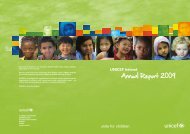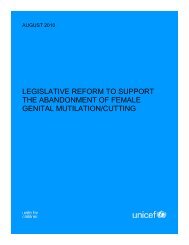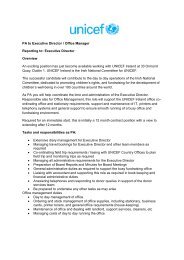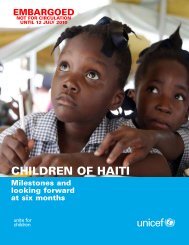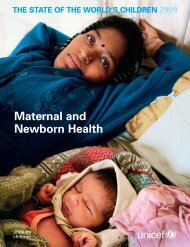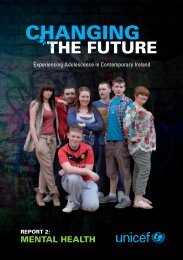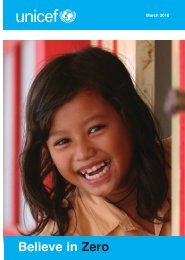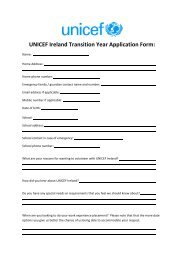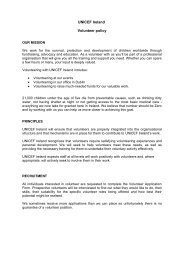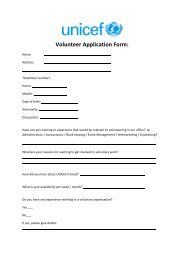Humanitarian Action for Children 2011 - Unicef
Humanitarian Action for Children 2011 - Unicef
Humanitarian Action for Children 2011 - Unicef
- No tags were found...
Create successful ePaper yourself
Turn your PDF publications into a flip-book with our unique Google optimized e-Paper software.
Uganda<strong>Children</strong> and women in crisisUganda is in the midst of an extensive recovery from a deep humanitarian crisis that affectedthe entire northern region. At the same time, recovery may also be affected by the Ugandanpresidential elections and the referendum in Sudan in early <strong>2011</strong>, which draft estimatessay may cause an additional 100,000 new refugees to seek shelter in Uganda. There arecurrently still over 112,000 1 displaced persons in northern Uganda, including 28,000 children.Additionally, climate change is expected to produce increasingly erratic rainfall, resulting infloods and landslides and exacerbating the effects of cyclic drought. Although severe acutemalnutrition and global acute malnutrition are below emergency levels, undernutrition ispersistent in the north and north-eastern regions and sanitation coverage in some districts issignificantly below the national average.<strong>Humanitarian</strong>funding at work:Highlights from 2010In 2010, UNICEF estimatedthat US$27,096,711was required to fund itshumanitarian work inUganda. As of end-October,only US$4,919,350 – 18 percent – had been received.This limited the scopeof UNICEF’s emergencyactivities, but significantresults were achievednonetheless. Nearly 12,000children with severe acutemalnutrition in the northand north-eastern regionsreceived treatment. In theaftermath of landslides ineastern Uganda, UNICEFhelped survivors gainaccess to water, sanitationand hygiene, and providedlearning and other safespaces <strong>for</strong> children. Inthe wake of cholera andhepatitis E outbreaks in theKaramoja region, UNICEFsupported WASH-relatedinterventions and helpedcommunities mobilizeto prevent disease fromspreading. UNICEF also wasable to build the protectionand emergency responsecapacities of District DisasterManagement Committeesin the north and northeasternregions by providingtraining in preparedness andresponse.Meeting urgent needs and building resilience in <strong>2011</strong>Following the handover of cluster coordination responsibilities in 2010, UNICEF’s work inUganda in <strong>2011</strong> will include ensuring continued coordination of cluster activities throughthe delegated agencies responsible <strong>for</strong> managing humanitarian response. UNICEF expectsto partner closely with the Government of Uganda, other UN agencies and a host of nongovernmentalorganizations to meet the humanitarian needs of around 732,000 people,including approximately 183,000 children.• UNICEF will equip and train staff in 115 health facilities to identify and manage treatment of13,000 children with severe acute malnutrition.• Preventive and curative health services will be provided <strong>for</strong> children under age 5 andpregnant women in camps <strong>for</strong> internally displaced persons, areas of return and emergencyaffectedregions.• UNICEF will support scale-up and implementation of community case management and commoditysecurity <strong>for</strong> essential drugs so that women and children included in the 732,000 targetedcaseload <strong>for</strong> <strong>2011</strong> are more resilient to potential emergencies. Nearly 4 million people are atrisk of meningitis in Uganda, and UNICEF will help carry out national vaccination campaigns.• 232,000 people in areas affected by drought or flooding, places experiencing outbreaks ofwaterborne diseases, or remaining vulnerable people in <strong>for</strong>mer internally displaced personcamps will benefit from improved access to safe water and sanitation.• Around 780,000 students, 50 per cent boys and 50 per cent girls, in the north and northeasternregions and in new refugee communities will have better access to safe learningenvironments crucial to education and well-being.• UNICEF will help protect and reintegrate more than 250,000 children who have returned fromnorthern Uganda’s internally displaced community to areas of origin. UNICEF will help thesechildren access existing social services and will respond to any violence against them.• Potential fallout from the referendum in neighbouring Sudan is part of UNICEF’s multihazardpreparedness plan, based on figures developed as part of the organization’s regionalplanning approach.• UNICEF’s ef<strong>for</strong>ts to build the capacity of national partners to prepare <strong>for</strong> and respond tovarious types of emergencies will also remain an important focus.Funding requirements <strong>for</strong> <strong>2011</strong>In the context of reduced humanitarian focus and increased recovery programming, UNICEF isrequesting US$10 million <strong>for</strong> its <strong>2011</strong> humanitarian work in Uganda, less than half of what wasrequested <strong>for</strong> 2010. Full funding will enable the organization to maximize its positive impact onthe lives of children and their families at a crucial moment in Uganda’s history.More in<strong>for</strong>mation on achievements of 2010 and the humanitarian action planned <strong>for</strong>Uganda in <strong>2011</strong> can be found at www.unicef.org/hac<strong>2011</strong>.1. United Nations High Commissioner <strong>for</strong> Refugees, ‘UNHCR Operation in Uganda: Fact Sheet’, UNHCR, Kampala,19 November 2010, p. 1.UNICEF EMERGENCY NEEDS FOR <strong>2011</strong> (in US dollars)Total $10,000,0002,000,000 Health1,500,000 Child protection3,000,000 Nutrition2,000,000 WASH1,500,000 Education42 <strong>2011</strong> UNICEF <strong>Humanitarian</strong> <strong>Action</strong> FOR CHILDREN | www.unicef.org/hac<strong>2011</strong>Uganda




